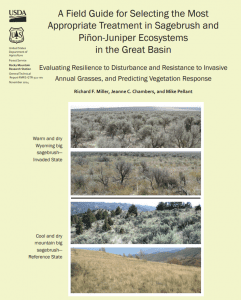Restoration
View research brief.
This research brief summarizes a series of interviews with land managers who make decisions about post-fire rehabilitation and restoration. These interviews explored barriers to improving post-fire recovery that included: policies and funding cycles that constrain managers’ ability to monitor and re-treat effectively, pressure and legal action from interest groups, pressure from concerned public/neighbors, climate change, and ecological debates such as native vs. non-native species use. These identified barriers provide a social-political-ecological framework that may influence on-the-ground manager decisions after wildfires in the Great Basin.
View guide.
In this study, researchers modeled the climatic envelope for subspecies wyomingensis for contemporary and future climates (decade 2050). Comparison of the contemporary and decade 2050 models shows a predicted 39% loss of suitable climate. Much of this loss will occur in the Great Basin where impacts from increasing fire frequency and encroaching weeds have been eroding the A. tridentata landscape dominance and ecological functions. The goal of this study is to provide a management tool to promote successful restoration by predicting the geographic areas where climate is suitable for this subspecies.
View report.
The initial report includes actions to be implemented by Interior’s bureaus to immediately address the threat of rangeland fire to Western sagebrush-steppe landscapes and improve fire management efforts before the start of the 2015 wildfire season.
View research brief.
This research brief summarizes research that found seed harvester ants, along with small mammals, could have a large impact on reseeding
efforts after a fire. But the populations over time are not well known. The number of ants in burned areas is significantly greater than unburned areas, but this may be an initial, short-lived response.
View the Order.
This Order sets forth enhanced policies and strategies for preventing and
suppressing rangeland fire and for restoring sagebrush landscapes impacted by fire across the West. These actions are essential for conserving habitat for the greater sage-grouse as well as other
wildlife species and economic activity, such as ranching and recreation, associated with the sagebrush-steppe ecosystem in the Great Basin region.
View field guide.
This field guide identifies seven primary components that largely determine resilience to disturbance, as well as resistance to invasive grasses and plant succession following treatment of areas of concern. An evaluation score sheet is included for rating resilience to disturbance and resistance to invasive annual grasses and the probability of seeding success.
View memorandum.
This presidential memorandum outlines federal efforts and steps to reverse pollinator losses and help restore populations to healthy levels. The steps include the development of new public-private partnerships and increased citizen engagement.
View report.
In a study of arid areas of western North America, soil inclusions called slickspots, which are saltier than adjacent soil and support different types of native vegetation, USGS scientists monitored slickspot size and cover of endangered slickspot peppergrass for two years to see if they were affected by the application of glyphosate or by a minimum-till drill in the Snake River Plain, ID. The researchers concluded that slickspot sizes were not affected by these treatments.
View strategy.
This Research Strategy provides an outline of important research topics to ensure that science information gaps are identified and documented in a comprehensive manner. Further, by identifying priority topics and critical information needed for planning, research, and resource management, it provides a structure to help coordinate members of an expansive research and management community in their efforts to conduct priority research.
View article.
For this study, hydrothermal germination models and a soil energy and water flux model were used to evaluate intra- and interannual variability in seedbed microclimate relative to potential germination response of six perennial grasses and cheatgrass.


